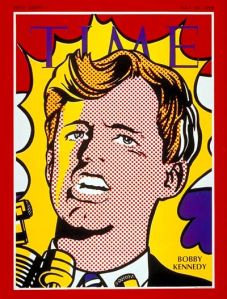Bobby Kennedy, Roy Lichtenstein, and the Horrors of 1968
In the spring of 1968 Robert F. Kennedy was running an insurgent anti-war candidacy for the presidency of the United States. Late to declare and hobbled by an archaic Democratic Party nominating system (the primaries would be dramatically revamped and expanded for 1972), the slain president’s younger brother had nonetheless by late May managed to garner huge attention, win a string of state contests, and — some argue — position himself for a shot at his party’s nomination.
 To capture the frenetic youthful energy of RFK’s campaign, Time magazine commissioned a cover image from celebrated pop artist Roy Lichtenstein. Already an art-world star by 1968, Lichtenstein’s signature technique adapted the colors, subjects, and technique of comic books and newspaper cartoons for his paintings. For his Kennedy cover, Lichtenstein depicted the senator declaiming at a podium, framed by a red-white-and-blue background and haloed by a dynamic yellow sunburst.
To capture the frenetic youthful energy of RFK’s campaign, Time magazine commissioned a cover image from celebrated pop artist Roy Lichtenstein. Already an art-world star by 1968, Lichtenstein’s signature technique adapted the colors, subjects, and technique of comic books and newspaper cartoons for his paintings. For his Kennedy cover, Lichtenstein depicted the senator declaiming at a podium, framed by a red-white-and-blue background and haloed by a dynamic yellow sunburst.
It was a striking image, and soon a creepily prescient one. Three weeks after the issue appeared, Bobby Kennedy was dead — shot in the head just after giving a televised speech at just such a podium. (One famous photo taken after the shooting recapitulates the cover image in an unsettling way.)
Shortly after the assassination Time ran another Lichtenstein cover. Painted simultaneously with the Kennedy
 To capture the frenetic youthful energy of RFK’s campaign, Time magazine commissioned a cover image from celebrated pop artist Roy Lichtenstein. Already an art-world star by 1968, Lichtenstein’s signature technique adapted the colors, subjects, and technique of comic books and newspaper cartoons for his paintings. For his Kennedy cover, Lichtenstein depicted the senator declaiming at a podium, framed by a red-white-and-blue background and haloed by a dynamic yellow sunburst.
To capture the frenetic youthful energy of RFK’s campaign, Time magazine commissioned a cover image from celebrated pop artist Roy Lichtenstein. Already an art-world star by 1968, Lichtenstein’s signature technique adapted the colors, subjects, and technique of comic books and newspaper cartoons for his paintings. For his Kennedy cover, Lichtenstein depicted the senator declaiming at a podium, framed by a red-white-and-blue background and haloed by a dynamic yellow sunburst.It was a striking image, and soon a creepily prescient one. Three weeks after the issue appeared, Bobby Kennedy was dead — shot in the head just after giving a televised speech at just such a podium. (One famous photo taken after the shooting recapitulates the cover image in an unsettling way.)
Shortly after the assassination Time ran another Lichtenstein cover. Painted simultaneously with the Kennedy
